
9 Show Low Boondocking Locations Best Off-Grid Camping: If you’re hunting for solid boondocking locations around Show Low, Arizona, you’ve actually got some pretty great spots to check out. The forests and open lands near Show Low—especially around Apache-Sitgreaves National Forest—have free dispersed camping where you can just pull in and settle down without the usual crowds. You’ll get plenty of quiet, open space for your RV or tent, and a lot of the time you’re surrounded by tall pines and those classic mountain views.
There’s also Show Low boondocking near lakes and forested areas like Bear Canyon Lake or Chevelon Canyon. These places offer a nice mix of water and woods—way different from the Sonoran Desert vibe. Show Low sits up in the cool, forested high country, so you get a very different feel up here. If you’re up for a drive, Canyon de Chelly is farther out but it’s a jaw-dropping spot for anyone who wants some history and epic canyon scenery.
If you’re into higher elevation forest camping or just want a quiet nook by a little lake, boondocking near Show Low gives you easy access to peaceful nature. No need for campground reservations, either. Just find a spot, settle in, and let the outdoors do its thing.
Description And Information About This Location
When you pick boondocking, you’ll spot a bunch of dispersed camping options in the area. These campsites don’t have hookups or services, so you’ll need to show up ready to handle your own needs.
Most of these Show Low boondocking sites sit in the Coconino National Forest. It’s a very natural setting with lots of elbow room—pretty ideal for family camping if you want some peace and quiet.
You’ll find places where you can park your RV or pitch a tent far from the usual campground crowds. You might see fire rings or picnic tables here and there, but don’t count on water or power.
Dispersed camping gives you more privacy and a closer connection to nature. Just remember, you’ve got to pack out your trash and follow any fire restrictions. That’s how we all keep the forest nice for the next folks.
If you want a few comforts, Show Low itself is just a short drive away. You’ll find grocery stores, gas, and restaurants if you need to restock or just want a burger after a day outside.
Here’s a quick rundown of what to expect when you’re Show Low boondocking:
| Feature | Description |
|---|---|
| Location | Coconino National Forest area |
| Services | None or very limited |
| Suitable for | RVs, tents, family camping |
| Nearby town amenities | Shopping, gas, food in Show Low |
| Rules | Pack out all trash, follow fire bans |
This spot works best for campers who want a simple, quiet experience and don’t mind roughing it a bit.
Location And Access
Boondocking near Show Low gives you a bunch of choices throughout the White Mountains. You’ll find sites around Show Low, Pinetop-Lakeside, and up by the Mogollon Rim. These areas are pretty raw—perfect if you like to do things yourself.
Most sites are down forest roads or dirt tracks. Some of those roads get bumpy, so a high-clearance vehicle makes life easier. There are also options near Springerville, but always check the latest road conditions before you head out.
A few key areas worth a look:
| Area | Description | Access Notes |
|---|---|---|
| Show Low | Close to town, some easy spots | Some sites near paved roads |
| Pinetop-Lakeside | Wooded, more trees | Forest roads can be rough |
| Mogollon Rim | Higher up, great views | Roads might get steep/narrow |
| Springerville | Quieter, less traffic | Pretty remote, 4WD helps |
Most of this camping is on U.S. Forest Service land, so you’ll need to stick to the 14-day stay limit. Cell service can be hit or miss, so bring enough supplies and a real map just in case.
You can Show Low boondocking spots using apps or local maps, but always park away from water and trails. That helps keep these places nice for everyone.
Directions: How To Get There And What To Expect
To get to boondocking spots near Show Low, start on Highway 260. If you’re coming from up north, that’s your main route to most of the camping areas, including those tucked into the national forests.
One of the easier access points is near Lake Mary Road. From Show Low, just head southeast on Hwy 260 for about 4 miles, then turn off onto Lake Mary Road or whichever forest road you’re aiming for. Most of these sites aren’t really marked, so keep your eyes open.
You won’t find hookups or facilities at these campsites, so bring what you need—water, food, and a plan for your trash. The sites are usually quiet and way out of sight from the main campgrounds.
A lot of the roads are gravel or dirt. If you’re hauling a big trailer or a 5th wheel, go slow and check your clearance. Some of the ruts can be pretty nasty. A map or GPS is handy, since your phone might not work out there.
Stick to Leave No Trace. Pack out what you pack in, and leave things as you found them. You’ll get big skies, pine forests, and a real sense of being out there—sometimes, it’s almost too quiet.
Amenities And Activities
When you pick a Show Low boondocking, you’re close to a ton of outdoor stuff. Fishing’s a big deal at lakes like Woods Canyon Lake, Fool Hollow Lake, and Big Lake. You’ll probably pull in some trout and enjoy the calm, scenic vibe.
Wildlife’s everywhere—deer, birds, and who knows what else around Show Low boondocking spots and Kaibab Lake. Bring binoculars if you want to really get into it.
If you’re into paddling, you can kayak on Ashurst Lake. It’s usually pretty mellow—good for a lazy afternoon. Salt River Canyon is nearby and has some great hiking and epic views, but don’t plan on boating there.
Amenities are hit or miss. Some places have picnic tables, fire rings, or vault toilets, but don’t expect much. The more developed campgrounds near Show Low have water and trash bins, but those aren’t the norm for dispersed sites.
Here’s a quick list of things you might want to try:
- Fishing at Woods Canyon, Fool Hollow, or Marshall Lake
- Kayaking on Ashurst Lake
- Hiking the trails in Salt River Canyon
- Wildlife spotting at Show Low Lake and Kaibab Lake
Depending on where you end up, your experience could be totally different, so it’s smart to plan ahead and match your interests with what’s actually available.
Camping Regulations And Restrictions
If you’re at a Show Low boondocking, you’ll need to stick to some rules to keep the forest healthy and everyone safe. Most dispersed camping spots in Apache-Sitgreaves National Forests don’t have toilets or running water, so come prepared with everything you need—including water and waste bags.
Fire restrictions are common. When Stage 2 fire restrictions kick in, no open fires are allowed at all. You can still use gas or propane stoves, but always double-check the current rules before you light anything.
Camping is free in these areas, but you need to camp at least 200 feet from water to help protect the streams and lakes. Developed campgrounds require a fee, so don’t set up there unless you’re paying.
Here are a few rules to keep in mind:
| Rule | Description |
|---|---|
| Stay 200+ feet from water | Protects streams and lakes |
| No open fires during restrictions | Use gas or propane stoves only |
| Pack out all trash | Leave no trace principles |
| Camping time limit | Usually 14 days in one spot |
Stick to these and you’ll help keep the forest in good shape for the next round of campers.
Leave No Trace
Show Low boondocking usage means you’ve got to respect Leave No Trace principles. Pack out everything you bring in—yep, even the food scraps. If everyone does their part, these places stay nice for a long time.
Try not to mess with plants, animals, or cool rocks you find. Stick to roads and established campsites, because going off-trail can really mess up the area for years.
If you build a fire, use an existing ring or pit. Make sure it’s out cold before you leave. If fires aren’t allowed, just use your camp stove.
Handle waste properly. Bring a portable toilet or, if you have to, bury human waste at least 6-8 inches deep and 200 feet from water.
Keep it down—nobody likes a loud neighbor when they’re out in the woods. Give the wildlife some space, too.
Key Points:
| What to Do | What to Avoid |
|---|---|
| Pack out all trash | Leaving trash or scraps |
| Stay on roads and campsites | Walking or driving off-trail |
| Use fire rings or camp stoves | Building new campfires |
| Properly dispose of waste | Polluting water sources |
| Keep noise low | Disturbing wildlife |
If we all follow these basics, Show Low’s boondocking spots will stay wild and welcoming for a long time.
Helpful Information Links
Bureau of Land Management
Recreation.Gov
National Park Service
Arizona Park Service
Arizona Trust
Arizona Fish and Game
Over 10,000 Free Boondocking Locations
Boondocking Recipes for 1000’s Of Camping Meals
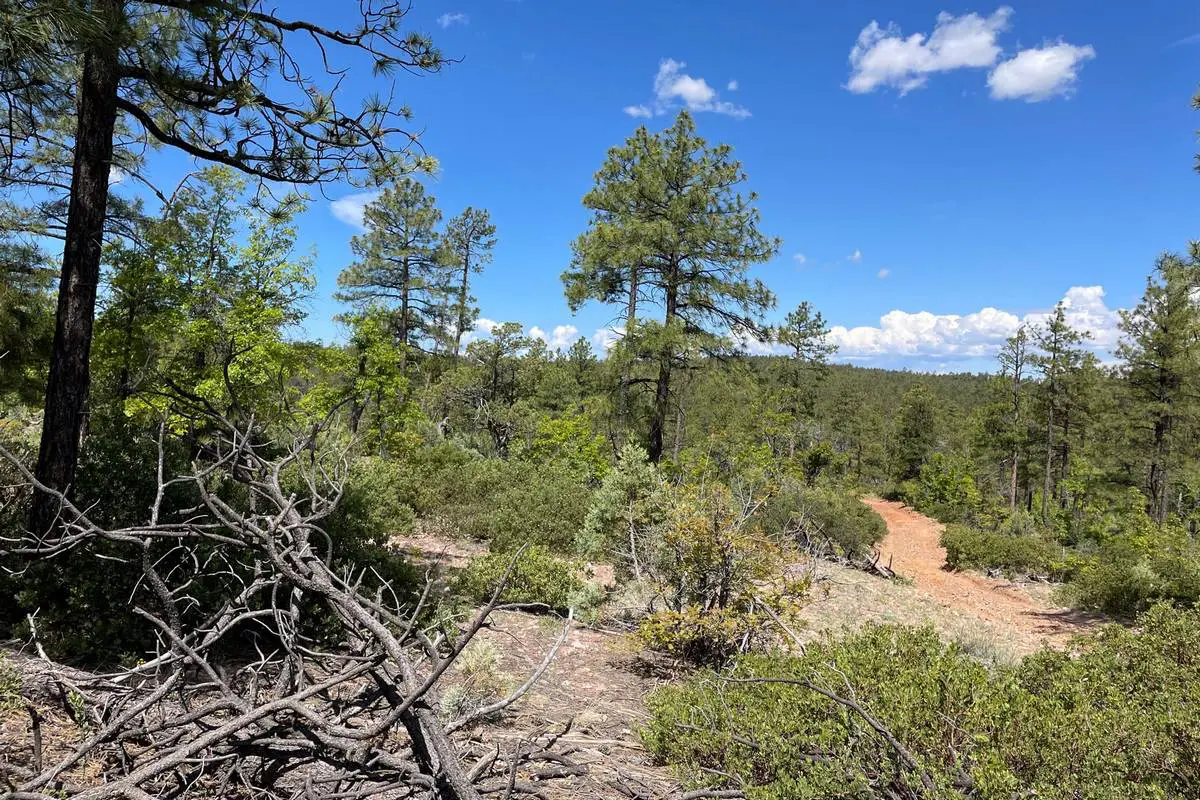
Show Low Boondocking Locations Best Off-Grid Camping
Free Boondocking Locations
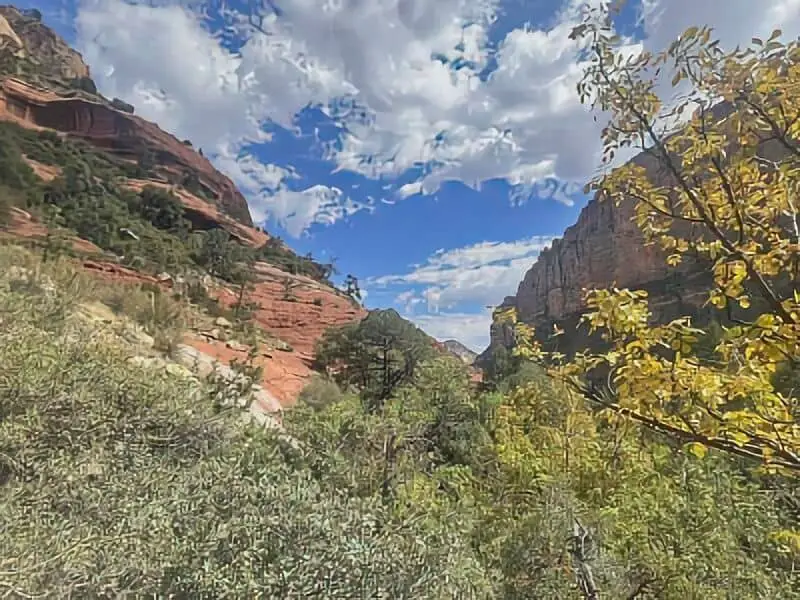
Los Burros
34.141178, -109.776392
Situated along Forest Service Road 300, commonly known as the Mogollon Rim Road, this Show Low boondockin site lies approximately five miles from Show Low, Arizona. The area offers dispersed camping amidst a forested landscape, providing a serene environment for campers seeking solitude and a connection with nature. The elevation is around 6,800 feet, offering cooler temperatures during the summer months. Campers should note that there are no amenities such as potable water or restrooms, so it’s essential to come prepared.
Things to Do:
The Show Low boondocking site allows campers to explore local attractions such as Fool Hollow Lake Recreation Area, which offers fishing, boating, and hiking opportunities. Additionally, the Mogollon Rim provides panoramic views and numerous trails for hiking and wildlife observation. The area is also known for its abundant wildlife, including elk, deer, and various bird species, making it a haven for nature enthusiasts and photographers.
Directions:
From Show Low, head east on AZ-260 E for approximately 2 miles. Turn left onto Forest Service Road 300 (Mogollon Rim Road) and continue for about 3 miles to reach dispersed camping areas. The road is well-marked, and several pull-offs along the way offer suitable spots for camping.
Vehicle Access:
Forest Service Road 300 is a graded gravel road accessible by most vehicles in dry conditions. However, during or after inclement weather, the road may become challenging for low-clearance vehicles. It’s advisable to check road conditions before traveling. Larger RVs may find limited space for maneuvering, so smaller rigs or tent camping are more suitable.
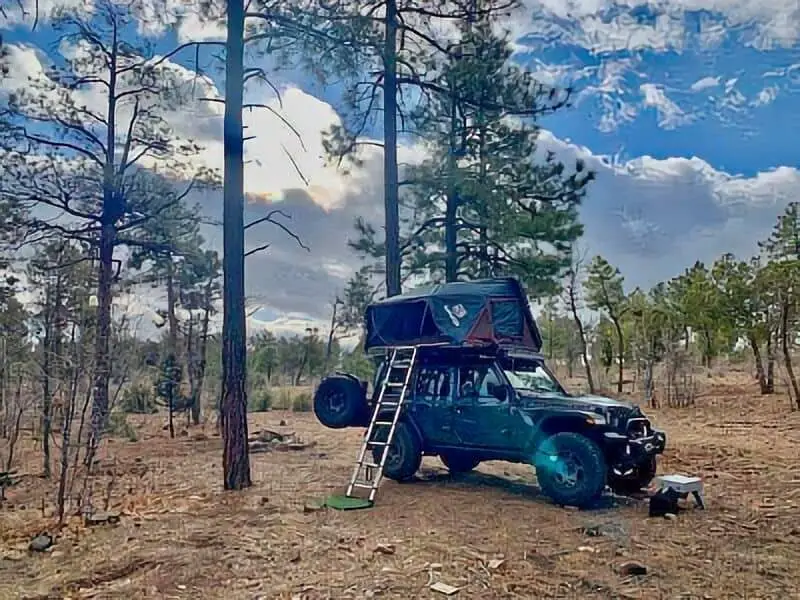
Boondocking Show Low
34.206696, -110.098562
Situated near the banks of the North Fork of the White River on the Fort Apache Indian Reservation, Ditch Camp offers a primitive camping experience in a forested setting. The campground is maintained by the White Mountain Apache Tribe Game & Fish and features five designated campsites. The area is characterized by its dense pine forests and proximity to the river, providing a tranquil environment for campers seeking solitude and a connection with nature.
Things to Do:
The nearby North Fork of the White River is designated as a “Catch-and-Release” area, providing opportunities for fly fishing, particularly for brown trout and the rare Apache trout. The surrounding forest offers trails for hiking and wildlife viewing. Additionally, the Fort Apache Historic Park, located nearby, offers a glimpse into the rich history of the area, including the former military fort and the Theodore Roosevelt School.
Directions:
From Pinetop, Arizona, take AZ-260 E for approximately 15 miles. Turn right onto AZ-73 S and continue for about 6 miles. Turn left onto Forest Road 116 and follow signs to Ditch Camp. The roads are generally well-maintained, but it’s advisable to check conditions before traveling, especially during or after adverse weather.
Vehicle Access:
Access roads to the Show Low boondocking site at Ditch Camp are unpaved and may be rough in certain areas. High-clearance vehicles are recommended, especially during or after adverse weather conditions. Larger RVs may find the roads challenging due to narrow passages and limited turnaround spots.
Arizona Land Trust Permit Sites

Ditch Camp
34.018871, -109.658713
Situated near the banks of the North Fork of the White River on the White Mountain Apache Reservation, Ditch Camp offers a primitive camping experience in a forested setting. The campground is maintained by the White Mountain Apache Tribe Game & Fish and features five designated campsites.
Things to Do:
The nearby North Fork of the White River is designated as a “Catch-and-Release” area, providing opportunities for fly fishing, particularly for brown trout and the rare Apache trout. The surrounding forest offers trails for hiking and wildlife viewing.
Directions:
From Pinetop, Arizona, take AZ-260 E for approximately 15 miles. Turn right onto AZ-73 S and continue for about 6 miles. Turn left onto Forest Road 116 and follow signs to Ditch Camp.
Vehicle Access:
Access roads to Ditch Camp are unpaved and may be rough in certain areas. High-clearance vehicles are recommended, especially during or after adverse weather conditions.

Diamond Creek 2
33.907727, -109.918429
Situated within the Apache-Sitgreaves National Forests, Diamond Creek Number 2 Campground offers a rugged camping experience amidst sparse vegetation and uneven terrain. The campground features tent sites and is suitable for campers seeking solitude and a connection with nature. The area is characterized by its remote location, providing a peaceful environment away from the hustle and bustle of city life.
Things to Do:
The surrounding national forest provides opportunities for hiking, wildlife viewing, and exploring the diverse ecosystems of the area. The remote location offers a tranquil environment for nature enthusiasts. Nearby trails offer varying levels of difficulty, catering to both novice and experienced hikers. Birdwatchers will appreciate the variety of species that inhabit the area, including hawks, owls, and songbirds.
Directions:
From Whiteriver, Arizona, take AZ-73 N for approximately 10 miles. Turn right onto Forest Road 116 and continue for about 5 miles to reach the campground. The roads are unpaved and may be challenging for low-clearance vehicles, so it’s advisable to check conditions before traveling.
Vehicle Access:
Access roads to Diamond Creek Number Two Campground are unpaved and may be challenging for low-clearance vehicles. High-clearance vehicles are recommended, and it’s advisable to check road conditions before traveling. Larger RVs may find limited space for maneuvering, so smaller rigs or tent camping are more suitable

Diamond Creek 3
33.952663, -109.762465
Situated within the Apache-Sitgreaves National Forests, the Show Low boondocking site atDiamond Creek Number 3 Campground offers a primitive camping experience in a remote setting. The area features dispersed camping opportunities without designated campsites or amenities, providing a secluded environment for campers seeking solitude. The landscape is characterized by its rugged terrain and dense forests, offering a true backcountry experience.
Things to Do:
The surrounding forest offers trails for hiking and opportunities for wildlife observation. The remote location provides a peaceful environment for nature enthusiasts. Nearby streams and creeks offer fishing opportunities, while the dense forest is home to various wildlife species, including deer, elk, and numerous bird species. The area is also suitable for stargazing due to minimal light pollution.
Directions:
From Whiteriver, Arizona, take AZ-73 N for approximately 12 miles. Turn right onto Forest Road 116 and continue for about 7 miles to reach the campground. The roads are unpaved and may be rough in certain areas, so it’s advisable to check conditions before traveling.
Vehicle Access:
Access roads to Diamond Creek Number Three Campground are unpaved and may be rough in certain areas. High-clearance vehicles are recommended, especially during or after adverse weather conditions. Larger RVs may find the roads challenging due to narrow passages and limited turnaround spots.
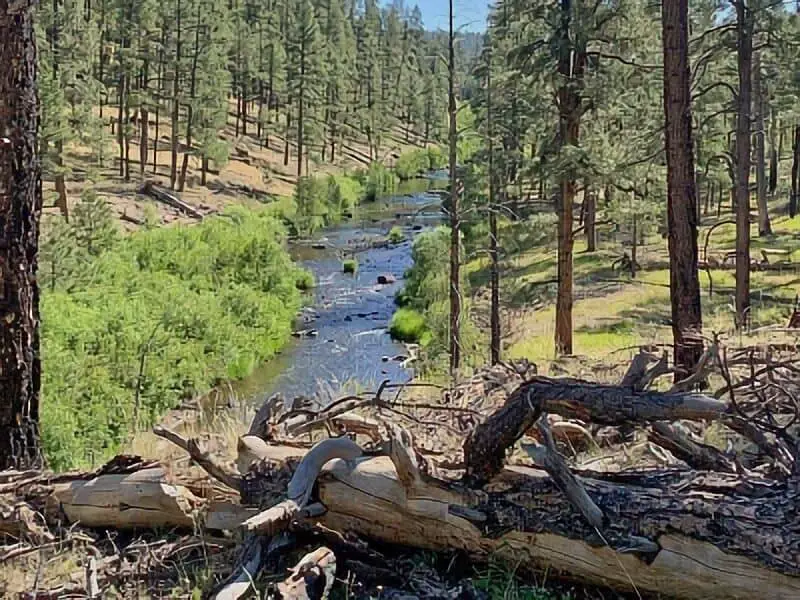
Diamond Creek Junction
33.893185, -109.933691
Situated in the Apache-Sitgreaves National Forests near Whiteriver, Arizona, Diamond Creek Junction offers a primitive camping experience in a remote forested setting. This area is managed by the White Mountain Apache Tribe, and camping here requires a valid permit, which can be obtained through the tribe’s Game & Fish Department. The campground is located at an elevation of approximately 7,800 feet, providing cooler temperatures during the summer months. Campers should be prepared for a lack of amenities, as there are no restrooms, potable water, or designated campsites. The area is favored by campers seeking solitude, nature, and a quiet environment.
Things to Do:
The surrounding Apache-Sitgreaves National Forests offer numerous opportunities for outdoor recreation, including hiking, wildlife viewing, and fishing. The nearby White River is known for its trout fishing, particularly for the rare Apache trout. Additionally, the Fort Apache Historic Park, located a short drive away, provides a glimpse into the rich history of the area, including the former military fort and the Theodore Roosevelt School.
Directions:
For this Show Low boondocking site from Whiteriver, Arizona, take AZ-73 N for approximately 10 miles. Turn right onto Forest Road 116 and continue for about 5 miles to reach the campground. The roads are unpaved and may be challenging for low-clearance vehicles, so it’s advisable to check conditions before traveling.
Vehicle Access:
Access roads to Diamond Creek Junction are unpaved and may be rough in certain areas. High-clearance vehicles are recommended, especially during or after adverse weather conditions. Larger RVs may find the roads challenging due to narrow passages and limited turnaround spots.
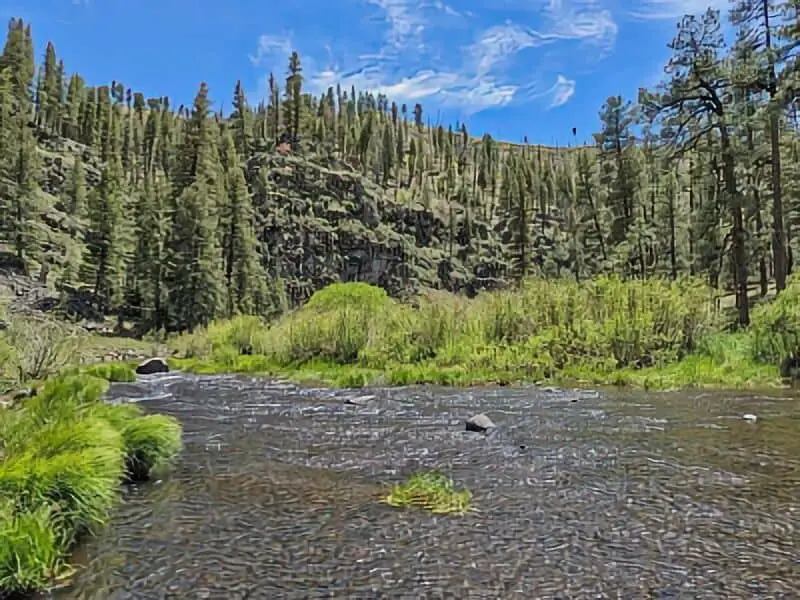
Alchesay Springs
33.924441, -109.935986
Situated near the White Mountains in Arizona, the Show Low boondocking site atAlchesay Springs Campground offers a primitive camping experience in a forested landscape of streams and dense vegetation. This area is managed by the White Mountain Apache Tribe, and camping here requires a valid permit. The campground is located at an elevation of approximately 7,000 feet, providing cooler temperatures during the summer months. Campers should be prepared for a lack of amenities, as there are no restrooms, potable water, or designated campsites. The area is favored by campers seeking solitude, nature, and a quiet environment.
Things to Do:
The surrounding area offers numerous opportunities for outdoor recreation, including hiking, wildlife viewing, and fishing. The nearby White River is known for its trout fishing, particularly for the rare Apache trout. Additionally, the Fort Apache Historic Park, located a short drive away, provides a glimpse into the rich history of the area, including the former military fort and the Theodore Roosevelt School.
Directions:
From Whiteriver, Arizona, take AZ-73 N for approximately 4 miles. Turn right onto Indian Route 61 and continue for about 4.6 miles to reach the campground. The roads are unpaved and may be challenging for low-clearance vehicles, so it’s advisable to check conditions before traveling.
Vehicle Access:
Access roads to Alchesay Springs Campground are unpaved and may be rough in certain areas. High-clearance vehicles are recommended, especially during or after adverse weather conditions. Larger RVs may find the roads challenging due to narrow passages and limited turnaround spots.
Paid Campgrounds
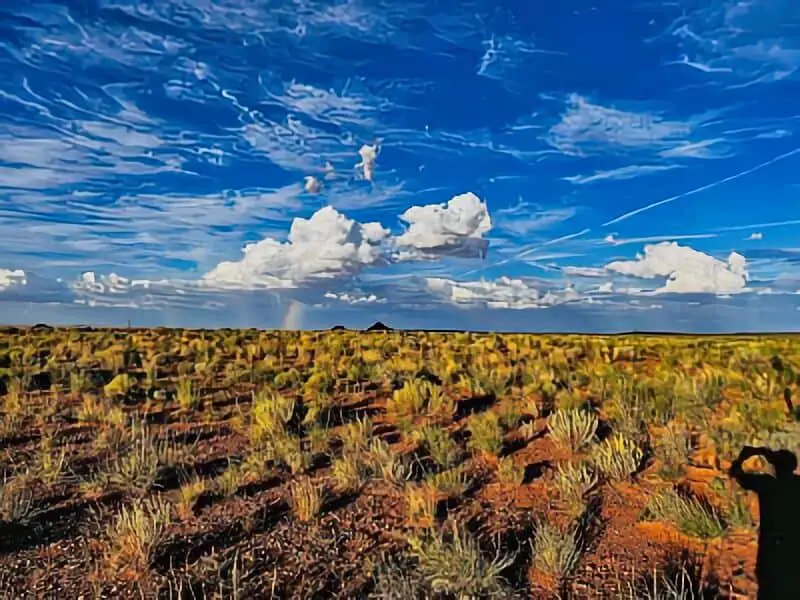
Bog Tank
34.053792, -109.728442
Situated on the Fort Apache Indian Reservation in Arizona, Bog Tank Campground offers a primitive camping experience in a forested setting near a small stream. This area is managed by the White Mountain Apache Tribe, and camping here requires a valid permit. The campground is located at an elevation of approximately 7,926 feet, providing cooler temperatures during the summer months. Campers should be prepared for a lack of amenities, as there are no restrooms, potable water, or designated campsites. The area is favored by campers seeking solitude, nature, and a quiet environment.
Things to Do:
This Show Low boondocking site and its surrounding area offers numerous opportunities for outdoor recreation, including hiking, wildlife viewing, and fishing. The nearby stream is known for its trout fishing. Additionally, the Fort Apache Historic Park, located a short drive away, provides a glimpse into the rich history of the area, including the former military fort and the Theodore Roosevelt School.
Directions:
From Whiteriver, Arizona, take AZ-73 N for approximately 15 miles. Turn right onto Forest Road 116 and continue for about 5 miles to reach the campground. The roads are unpaved and may be challenging for low-clearance vehicles, so it’s advisable to check conditions before traveling.
Vehicle Access:
Access roads to Bog Tank Campground are unpaved and may be rough in certain areas. High-clearance vehicles are recommended, especially during or after adverse weather conditions. Larger RVs may find the roads challenging due to narrow passages and limited turnaround spots.

Cooley Lake
34.071269, -109.911098
Situated near McNary, Arizona, Cooley Lake Campground offers a designated camping experience in a forested setting near a small lake. This Show Low boondocking site is managed by the White Mountain Apache Tribe, and camping here requires a valid permit. The campground is located at an elevation of approximately 7,164 feet, providing cooler temperatures during the summer months. The campground features 10 designated campsites suitable for tent camping. Campers should be prepared for a lack of amenities, as there are no restrooms or potable water. The area is favored by campers seeking solitude, nature, and a quiet environment.
Things to Do:
The surrounding area offers numerous opportunities for outdoor recreation, including hiking, wildlife viewing, and fishing. The nearby lake is known for its trout fishing. Additionally, the Fort Apache Historic Park, located a short drive away, provides a glimpse into the rich history of the area, including the former military fort and the Theodore Roosevelt School.
Directions:
From McNary, Arizona, take AZ-260 E for approximately 2 miles. Turn right onto Forest Road 116 and continue for about 3 miles to reach the campground. The roads are unpaved and may be challenging for low-clearance vehicles, so it’s advisable to check conditions before traveling.
Vehicle Access:
Access roads to Cooley Lake Campground are unpaved and may be rough in certain areas. High-clearance vehicles are recommended, especially during or after adverse weather conditions. Larger RVs may find the roads challenging due to narrow passages and limited turnaround spots.
Frequently Asked Questions
You’ve probably got questions about the rules, how long you can stay, and where to actually camp near Show Low—plus what you’ll find when you get there.
What are the legal requirements for dispersed camping in Arizona?
You need to camp on public land where it’s allowed. Don’t set up on private property unless you’ve got permission. And yeah, pack out your trash and follow Leave No Trace.
How do you locate a permissible Show Low boondocking site?
Check maps for national forests like Apache-Sitgreaves. Use websites and apps with camper reviews and photos. Local ranger stations are also a good bet for up-to-date info.
Can you boondock for free within Arizona’s national forests?
Absolutely. Lots of spots in the national forests are free as long as you’re away from developed campgrounds. Just make sure you’re at least 100 feet from water and roads.
What are some popular areas for Show Low boondocking sites?
Apache-Sitgreaves National Forest is the big one. Great Lake is just past Show Low and pretty popular, though it’s a bit higher up. You’ll find other spots all along the forest roads.
Are there any restrictions on the duration of stay while at a Show Low boondocking site?
Yep—most national forests limit you to 14 days in one spot within a 30-day period. After that, you’ve got to move at least 25 miles before you can come back.
What amenities should be expected at a Show Low boondocking site?
Don’t count on water, electricity, or restrooms—you’ll need to haul in your own supplies and pack out whatever you bring. A few spots might have a trailhead close by or a fire ring, but honestly, that’s about it.

